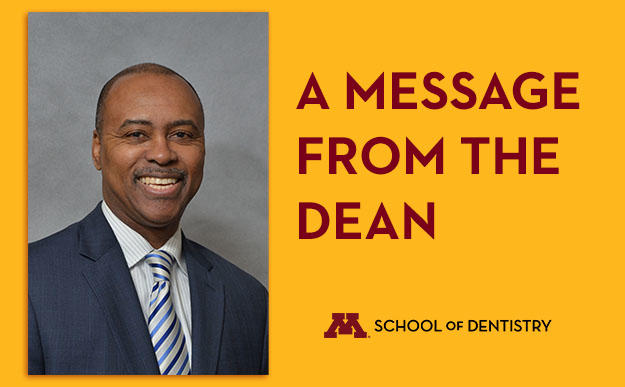Serving the Community | A Message from the Dean

“Of all the forms of inequality, injustice in health is the most shocking and the most inhuman because it often results in physical death."
Martin Luther King, Jr.
One of our core values is “service to all communities.” The educational model of our school has allowed us to fulfill this value and operate our Moos Tower clinics as safety-net clinics. Within our predoctoral clinics, we provide dental care to patients with commercial insurance, public insurance and no insurance at all. In 2000, Surgeon General David Satcher wrote Oral Health in America: A Report of the Surgeon General. This report presented the importance of oral health, and that having good oral health was more than just healthy teeth, by highlighting the role that saliva can play in providing information about our overall health. The report stated that “oral health is essential to the general health and well-being of all Americans.” For a variety of reasons, the patients treated in our clinics may have few options of places to seek care. By improving their oral health, we also positively impact their overall health.
A recent report from the Minnesota Department of Health (MDH) states that “disparities in Minnesota mean some populations bear more of the burden of oral disease.” The MDH recently released its second Oral Health Plan for the state, entitled Minnesota State Oral Health Plan for 2020-2030. I am proud to say that one of our own, Sheila Riggs, DDS, MS, DMSc, chaired the Dental Services Advisory Committee that served as one of the stakeholders providing input into this plan.
One of the five focal areas is access to oral health care, with a vision of “all Minnesotans having equitable opportunities to access to oral health care.” The School of Dentistry also strives to improve access to care for Minnesotans, especially those most vulnerable. In FY21, in our pre-doctoral clinics, we provided care to 20,833 patients who had public insurance and approximately 4,000 patients without insurance. Our patients come from all but four counties in Minnesota, and a few in Wisconsin and South Dakota. In addition, our dental, dental hygiene and dental therapy students provide care to underserved populations at affiliated Outreach sites, with more than 8,500 patient visits in FY21.
One of the challenges that the MDH plan highlights is that some patients cannot find a provider to treat them. That was the exact scenario that led to the death of twelve-year-old Deamonte Driver in 2007 after complications from an abscessed tooth. It is my hope that we will continue to provide our students with the experiences, training and knowledge that allow them to contribute to future reductions in oral health disparities within Minnesota and beyond. It is great to see our students coordinating the annual Give Kids a Smile clinic, which provides care to many patients who might otherwise not be able to get it. As a school, we strive to have interconnected programs between our research, our didactic instruction and our clinic experiences, working together to contribute to the reduction in oral health disparities. I am proud and thankful for the work that we have accomplished in this arena thus far and look forward to continued growth in our commitment to “serving all communities.”